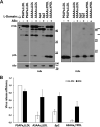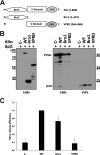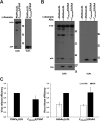Alix-Mediated Rescue of Feline Immunodeficiency Virus Budding Differs from That Observed with Human Immunodeficiency Virus
- PMID: 32213612
- PMCID: PMC7269445
- DOI: 10.1128/JVI.02019-19
Alix-Mediated Rescue of Feline Immunodeficiency Virus Budding Differs from That Observed with Human Immunodeficiency Virus
Abstract
The structural protein Gag is the only viral component required for retroviral budding from infected cells. Each of the three conserved domains-the matrix (MA), capsid (CA), and nucleocapsid (NC) domains-drives different phases of viral particle assembly and egress. Once virus assembly is complete, retroviruses, like most enveloped viruses, utilize host proteins to catalyze membrane fission and to free progeny virions. These proteins are members of the endosomal sorting complex required for transport (ESCRT), a cellular machinery that coats the inside of budding necks to perform membrane-modeling events necessary for particle abscission. The ESCRT is recruited through interactions with PTAP and LYPXnL, two highly conserved sequences named late (L) domains, which bind TSG101 and Alix, respectively. A TSG101-binding L-domain was identified in the p2 region of the feline immunodeficiency virus (FIV) Gag protein. Here, we show that the human protein Alix stimulates the release of virus from FIV-expressing human cells. Furthermore, we demonstrate that the Alix Bro1 domain rescues FIV mutants lacking a functional TSG101-interacting motif, independently of the entire p2 region and of the canonical Alix-binding L-domain(s) in FIV Gag. However, in contrast to the effect on human immunodeficiency virus type 1 (HIV-1), the C377,409S double mutation, which disrupts both CCHC zinc fingers in the NC domain, does not abrogate Alix-mediated virus rescue. These studies provide insight into conserved and divergent mechanisms of lentivirus-host interactions involved in virus budding.IMPORTANCE FIV is a nonprimate lentivirus that infects domestic cats and causes a syndrome that is reminiscent of AIDS in humans. Based on its similarity to HIV with regard to different molecular and biochemical properties, FIV represents an attractive model for the development of strategies to prevent and/or treat HIV infection. Here, we show that the Bro1 domain of the human cellular protein Alix is sufficient to rescue the budding of FIV mutants devoid of canonical L-domains. Furthermore, we demonstrate that the integrity of the CCHC motifs in the Gag NC domain is dispensable for Alix-mediated rescue of virus budding, suggesting the involvement of other regions of the Gag viral protein. Our research is pertinent to the identification of a conserved yet mechanistically divergent ESCRT-mediated lentivirus budding process in general, and to the role of Alix in particular, which underlies the complex viral-cellular network of interactions that promote late steps of the retroviral life cycle.
Keywords: Alix; feline immunodeficiency virus; late domain; nucleocapsid.
Copyright © 2020 American Society for Microbiology.
Figures





References
Publication types
MeSH terms
Substances
Associated data
LinkOut - more resources
Full Text Sources
Miscellaneous

